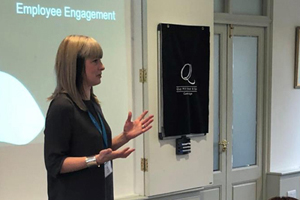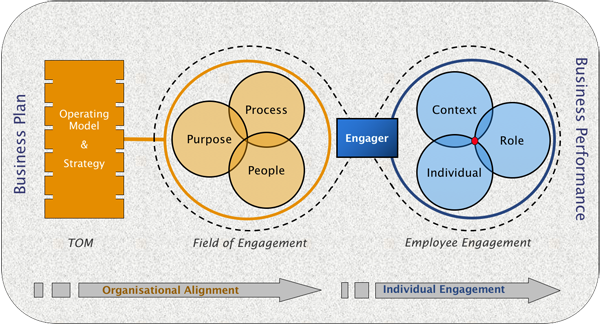Employee Engagement; The Bottom Line Is It’s Critical To Your Bottom Line… But How Do You Do It?
Author: Kath Howell, published: Apr 3, 18

Guest blog by Kath Howell of The Terrier Group.
Have you ever been so absorbed in your work that time ceased to exist - what felt like mid morning is mid afternoon, and you have experienced levels of productivity and creativity that have yielded real fruit? Many of us recognise this experience, but how many of us experience it at work? And regularly?
Mihaly Csikszentmihalyi has coined this experience as ‘Flow’ and researched the criteria that enable it. Answering this question is the nub of what we understand as the pursuit of ‘Employee Engagement’, where an engaged employee is one “who is fully involved in, and enthusiastic about, his or her role, and thus will willingly apply discretionary effort, and act in a way that furthers their organisation's interests”
Ask yourself an honest question:
In the real world of work, where we must do things faster, better, cheaper and stress is a daily reality, is there an unspoken thought along the lines of “Do I really care if my staff are having a jolly time?”
To be fair, for the majority the answer is yes… but after real business priorities are addressed…. the HR Director will sort it… and if only there was the time.
But can you separate the pursuit of business priorities from Employee Engagement? And can you limit it to the sphere of HR?

About The Terrier Group The Terrier Group is a tenacious consultancy that will chase a vision to conclusion. With fortitude and fun we stay in the game, challenging organisations to thrive instead of survive We offer Management Consultancy, Fractional Executive and Training. We specialise in the coupling of People (Employee Engagement), Purpose (strategy) and Process (Lean) to mobilise organisations towards powerful outcomes. http://www.theterriergroup.uk
...in 2008 disengagement cost the economy between £59.4 and £64.7 billion...
This seems a far-reaching claim, but when you examine the different elements that are attributable to Employee Engagement it becomes a more feasible story:- People Costs – absenteeism, staff turnover
- Productivity – tenacity, error rates, motivation, capacity constraints
- Service Levels – customer loyalty, first time fix
- Innovation – ideas, creativity, process improvement
Starting at the top
Lets be frank, creating Employee Engagement is not easy. Any intervention must have a sponsor with the capacity and courage to challenge the foundations of an organisation. It’s hard to see how this could be anything but the top team…. and here is why: As a management team, you have a business plan (usually), and you hope that it will result in business performance. But to move from left to right, there are a bunch of people and processes involved, this is where engagement affects outcomes, and they need to be optimised. The senior team are the only people that can drive those changes.
Field of Engagement
The foundations for Engagement occur at an organisational level, through addressing the 3 areas of Purpose, Process and People: Purpose - A clear, compelling and communicated organisational purpose. The aim is a purpose that resonates and is inherently understood by each individual, who has been able to interpret it to fit their world Process – Everyone likes to be competent and feel a sense of achievement, not thwarted in their attempts to succeed. Business processes must be slick and efficient, free from bureaucracy, silos and politics. People - ‘People’ policies and procedures need to offer a return on personal investment through fair management of performance and fair rewards - a flexible framework to apply to individuals.Engaging Leaders
The organisational practices may be first class, but will go nowhere in creating actual engagement by themselves. That is down to their application by managers and leaders within the organisation. People are different. Different in what motivates us, how we feel valued, what we are good at. Line managers are the only people in a position to understand each employee’s unique needs, and therefore interpret organisational policies to generate actual engagement.Actual Engagement
There are a further three factors affecting an individual’s ability to engage; Context, Role and the Individual. Context – The surrounding team and micro-culture. Whether you have fun at work and whether those around you are supportive - an environment where individuals can be themselves without fear of damaging self-image, status, or career. Role - Roles that are meaningful to individuals. In terms of the responsibilities matching their talent and preferences, and challenges matching ability. But also in terms of how they are executed - There needs to be sufficient autonomy so that individuals can find their own way of doing things, solve their own problems and implement their own ideas. Individual - Time for another honest question – ‘Can every individual be engaged’? This area acknowledges that there are some aspects to engagement that you simply cannot affect. To engage in a role, an individual must be personally available i.e. be physically, emotionally and psychologically able. There will inevitably be periods of fluctuation where tiredness, “the argument with the wife” and significant and tragic life events render us mentally unavailable for work, when there are simply bigger priorities in life. But Engagement is about the long haul, not a quick fix, accept it will never be perfect, but believe that we can improve things for the majority.So what?
Any decent Employee Engagement survey will measure these criteria in one form or another. Engagement levels are as good as the weakest link – analysis will identify that, and the intervention to address it should be reasonably obvious – from management development, to getting rid of a painful IT system or rescuing the original mission from the dry corporate communication. When that effect has been felt, re-measure and repeat – simple!In a nutshell…
So as we look back to the original question regarding flow – How can this be created across organisations? The answer is; when Engaging Leaders use Engagement friendly organisational policies to create a set of circumstances that move and mobilise each individual.About The Terrier Group The Terrier Group is a tenacious consultancy that will chase a vision to conclusion. With fortitude and fun we stay in the game, challenging organisations to thrive instead of survive We offer Management Consultancy, Fractional Executive and Training. We specialise in the coupling of People (Employee Engagement), Purpose (strategy) and Process (Lean) to mobilise organisations towards powerful outcomes. http://www.theterriergroup.uk